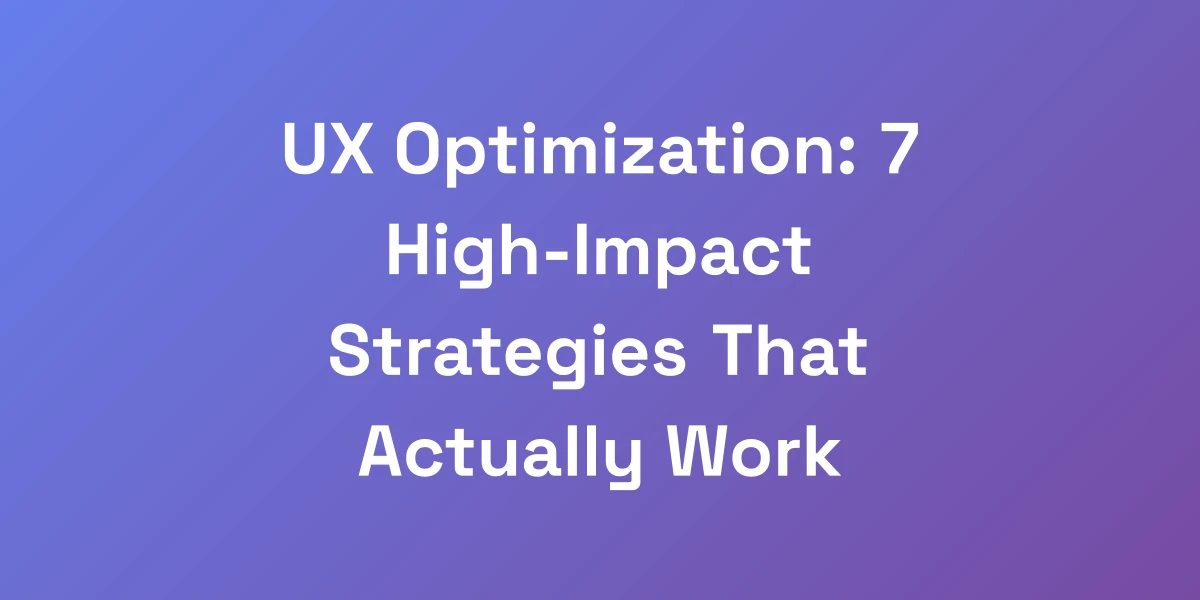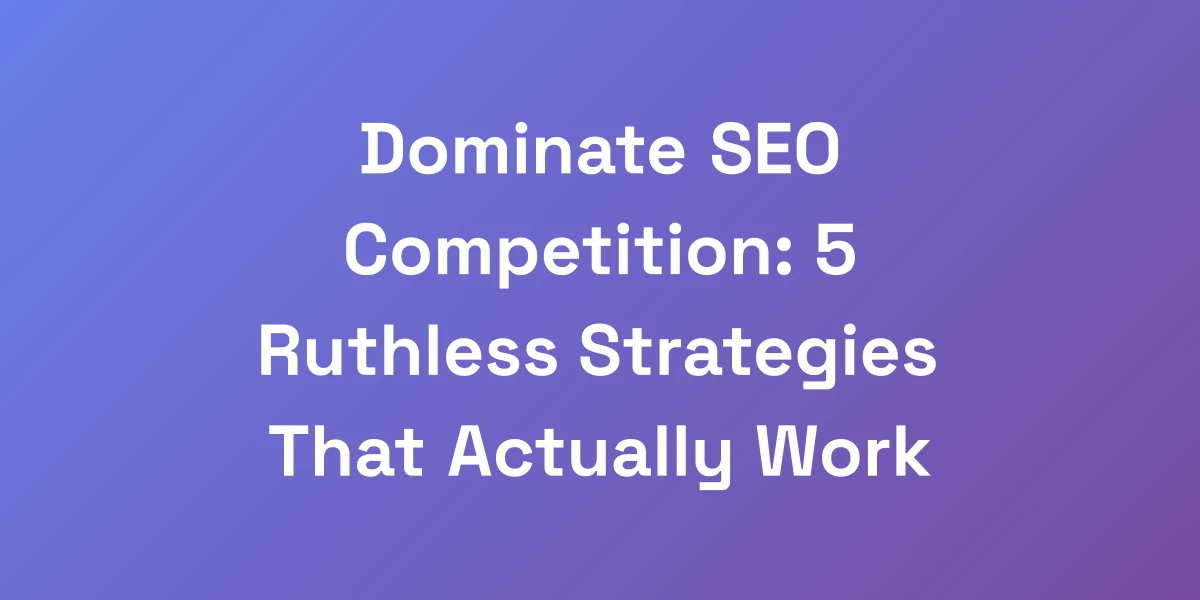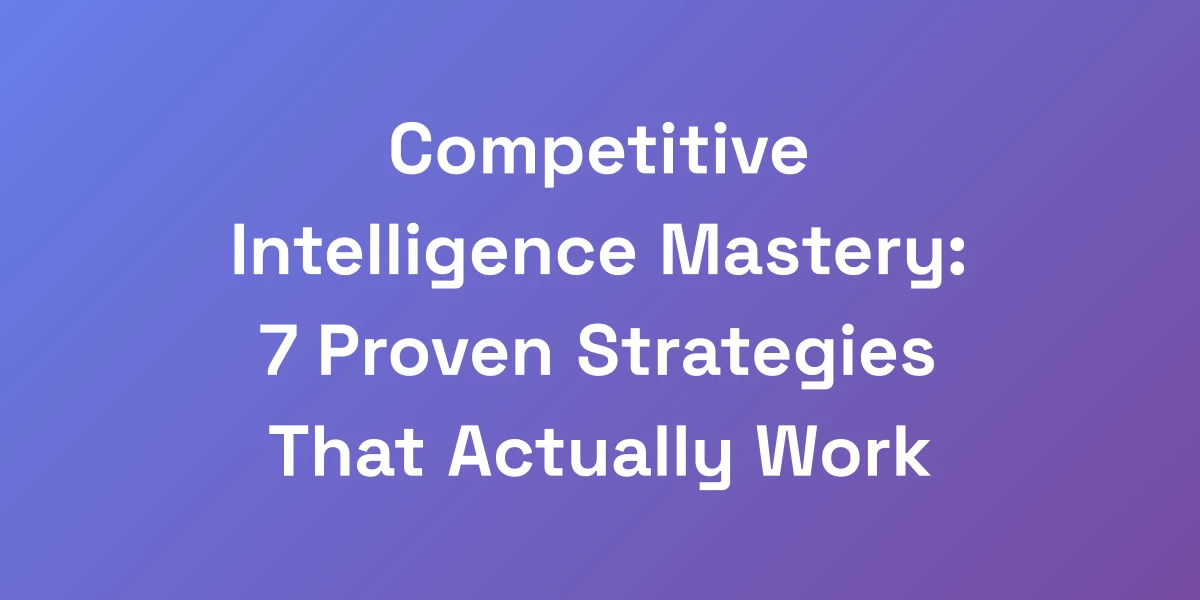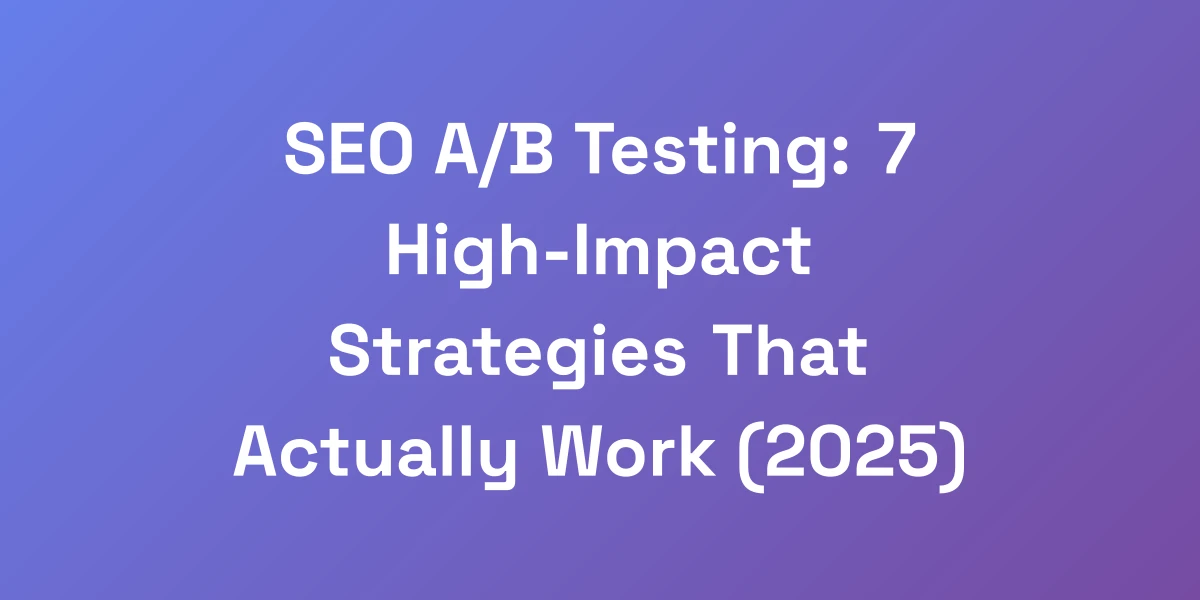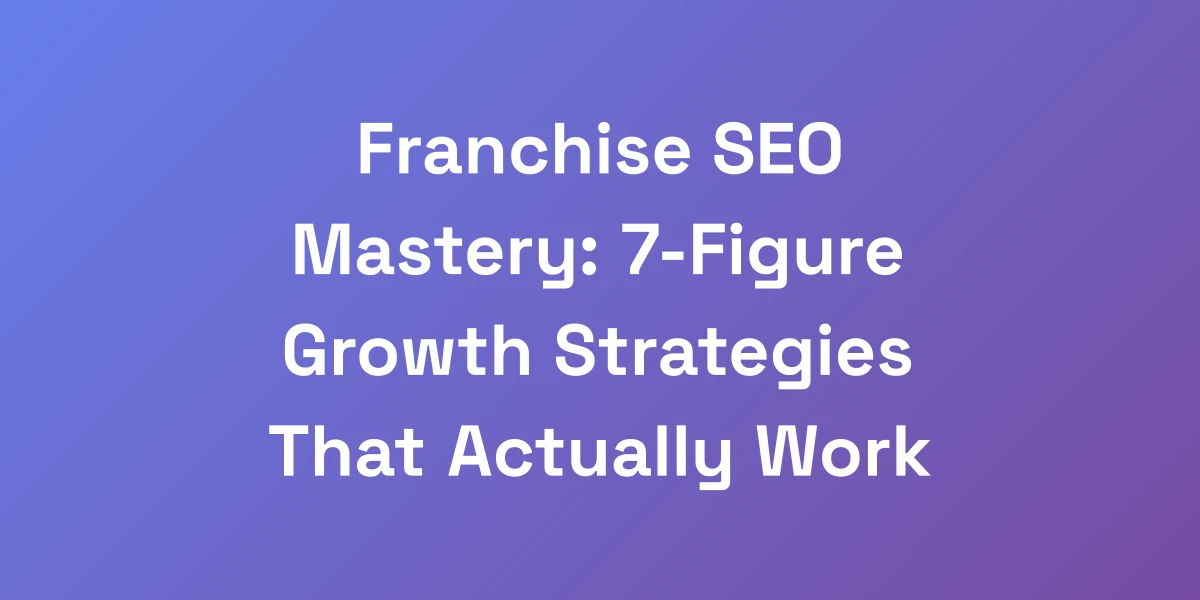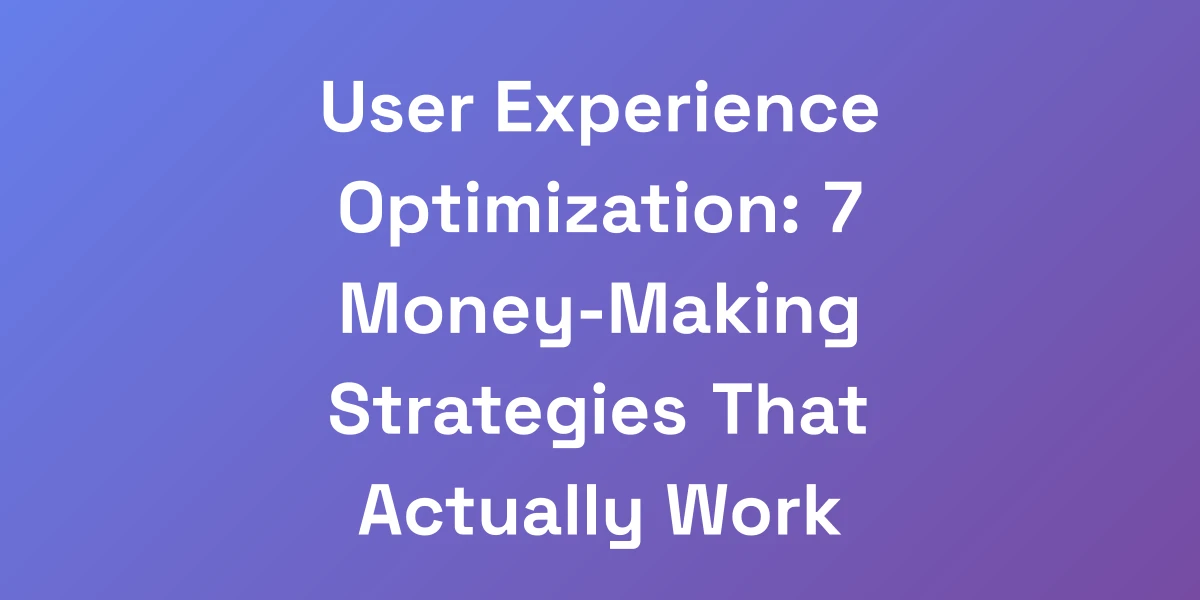
User Experience Optimization: 7 Money-Making Strategies That Actually Work
Mar 6, 2025 | By [email protected]
Introduction
Ever feel like your website or app isn’t pulling its weight? You’re not alone. User experience optimization is where the lion’s share of businesses stumble. They pour resources into flashy designs, thinking it’s the magic bullet for conversions. But here’s the hard truth: beautiful doesn’t always mean effective.
Imagine having a store with the most stunning window display, yet inside, customers can’t navigate or find what they need. Frustrating, right? That’s exactly what happens when companies ignore the core principles of UX. They miss out on turning visitors into loyal customers, bleeding potential revenue in the process. We’ve seen it time and again: companies overlook the psychology behind user behavior, and the fallout is disastrous.
In this article, we’re diving deep into 7 money-making UX strategies that go beyond aesthetics. We’re talking actionable, real-world tactics that drive conversions and boost your bottom line. Ready to transform your user experience from lackluster to lucrative? Let’s get started.
Why Most Companies Fail at User Experience (And How to Win)
Let me hit you with some truth: 90% of companies are bleeding money because they’re doing UX wrong. They’re obsessing over pretty designs while ignoring what actually moves the needle.
User experience optimization isn’t about making things look good – it’s about making things convert. In our years of user experience design for business growth, we’ve learned that the difference between a 1% and 10% conversion rate often comes down to understanding the psychology behind user behavior. The companies that win are the ones that optimize for human nature, not design trends.
The Real Cost of Poor User Experience
Investing in UX isn’t just a nice-to-have; it’s a financial lifeline. Did you know that every $1 invested in UX can bring back up to $100? That’s a staggering ROI of 9,900%.
- Imagine a website where users can’t find the checkout button. The cost? Lost sales and frustrated customers that never return.
- Slow load times can tank your conversion rates by 2% for every second of delay.
These aren’t just numbers; they represent real money slipping through your fingers because of overlooked UX flaws.
Psychology-Based UX Principles That Drive Sales
Understanding user psychology is the secret sauce to effective UX. People don’t always act rationally; their decisions are often influenced by subconscious triggers.
- Social Proof: Displaying testimonials and reviews builds trust and encourages conversions.
- Scarcity: Limited-time offers can create a sense of urgency, pushing users to act quickly.
- Consistency: A consistent design across your site reduces cognitive load, making it easier for users to navigate and complete actions.
By leveraging these psychological principles, we can design experiences that naturally guide users towards conversions.
Case Study: How We 10x’d Conversion Rates Through UX
One of our clients, an e-commerce platform, was struggling with a 1% conversion rate. We dove into their UX, identifying several pain points:
- Complex navigation that confused users.
- Lengthy checkout process causing cart abandonment.
- Lack of trust signals leading to hesitant buyers.
Implementing streamlined navigation, simplifying the checkout, and adding trust badges skyrocketed their conversion rate to 10%. This transformation didn’t just boost sales—it fundamentally changed their business trajectory.
The Three Pillars of High-Converting User Experience
To build a high-converting UX, focus on these three pillars:
- Usability: Ensure your site is easy to navigate, with intuitive layouts and clear pathways to action.
- Performance: Optimize load times and responsiveness to keep users engaged and reduce drop-offs.
- Trust: Incorporate elements that build credibility, such as testimonials, secure payment options, and professional design.
Mastering these pillars sets the foundation for a robust user experience that drives conversions and revenue.
Common UX Mistakes Killing Your Revenue
Beware of these common UX pitfalls that could be draining your profits:
- Overcomplicating Design: Too many elements can overwhelm users and obscure key actions.
- Poor Mobile Optimization: With over 50% of traffic coming from mobile, a subpar mobile experience is a major revenue killer.
- Ignoring User Feedback: Failing to listen to your users means missing out on crucial insights that could enhance your UX.
- Slow Load Times: Users expect speed; delays can lead to high bounce rates and lost sales.
By avoiding these mistakes, you can preserve your revenue and foster a better user experience.
Data-Driven UX Optimization Framework
Stop guessing what works. Start measuring what matters. The biggest leverage in user experience optimization comes from having a data-driven content marketing feedback loop that continuously improves your user experience based on real behavior, not opinions. We’ve used this exact framework to generate over $100M in revenue across multiple businesses. It’s not about following best practices – it’s about creating a feedback loop that continuously improves your user experience based on real behavior, not opinions. Here’s the exact process we use to turn data ROI tools into profit.
Setting Up Your UX Analytics Infrastructure
First things first, you need the right tools to capture user data. Setting up a robust analytics infrastructure is crucial.
- Google Analytics: The cornerstone of any analytics setup, providing comprehensive data on user behavior.
- Heatmap Tools: Tools like Hotjar or Plerdy help visualize where users are clicking and how they navigate your site.
- Session Recording: Watching real user sessions reveals pain points and opportunities for enhancement.
Investing time in setting up these tools ensures you have the data foundation necessary for effective UX optimization.
Key Metrics That Actually Matter for Revenue
Not all metrics are created equal. Focus on those that directly impact your revenue:
- Conversion Rate: The percentage of visitors who complete a desired action.
- Bounce Rate: The percentage of visitors who leave after viewing only one page.
- Average Session Duration: How long users stay on your site, indicating engagement levels.
- Task Success Rate: The percentage of users who successfully complete key tasks on your site.
Tracking these metrics helps you identify where improvements are needed to boost revenue.
User Behavior Tracking Tools and Implementation
Choosing the right tools can make or break your UX strategy. Here’s how to implement them effectively:
- Google Analytics: Set up custom goals and funnels to track conversion paths.
- Hotjar: Use heatmaps and session recordings to visualize user interactions.
- Mixpanel: Dive deeper into user engagement and retention with SEO for startups advanced analytics.
Integrate these tools into your workflow to gather detailed insights into user behavior, paving the way for informed UX decisions.
Creating Your UX Testing Framework
With data in hand, it’s time to test hypotheses and implement changes.
- A/B Testing: Compare different versions of a page to see which performs better.
- User Testing: Conduct tests with real users to gather qualitative feedback.
- Usability Testing: Assess how easily users can navigate and accomplish tasks on your site.
A robust testing framework allows you to validate changes and ensure they’re driving the desired results.
Interpreting Data for Maximum Impact
Data is only as good as your ability to interpret it. Here’s how to make sense of the numbers:
- Identify Patterns: Look for trends and commonalities in user behavior.
- Prioritize Issues: Focus on the problems that have the biggest impact on conversions.
- Iterate: Use your findings to make informed changes and continuously optimize.
By effectively interpreting your data, you can make strategic decisions that drive significant revenue growth.
Advanced User Research Techniques That Scale
Forget everything you know about traditional user research. In today’s digital landscape, you need methods that scale with your business.
The secret isn’t in running more surveys – it’s in extracting actionable insights from existing user behavior. We’re going to show you how we gather user insights that directly translate to revenue, without spending months on research. These are the exact techniques we’ve used to optimize user experiences across eight-figure businesses.
Automated User Behavior Analysis
Manual analysis just doesn’t cut it anymore. Automation is the key to scaling your user research efforts.
- AI Tools: Utilize AI-powered SEO automation tools to sift through massive amounts of user data quickly.
- Behavioral Segmentation: Automatically segment users based on their behavior patterns for targeted insights.
Automation not only saves time but also uncovers hidden patterns that might go unnoticed in manual analysis.
AI-Powered User Journey Mapping
Understanding the user journey is crucial for optimizing UX. AI-powered tools take this to the next level.
- Dynamic Mapping: AI can create real-time maps of user journeys, highlighting common paths and drop-off points.
- Predictive Insights: Predict where users are likely to encounter issues and address them proactively.
These capabilities allow for a more nuanced understanding of user interactions, leading to more effective optimization strategies. Learn how to make money with AI by leveraging these advanced techniques.
Heat Mapping and Session Recording at Scale
Heatmaps and session recordings are invaluable for visualizing user behavior, especially when scaled effectively.
- Comprehensive Coverage: Use tools like Hotjar or Plerdy to gather data from thousands of user sessions.
- Detailed Insights: Identify hotspots and friction points that need improvement.
Scaling these tools ensures you’re capturing diverse user interactions, providing a deeper understanding of how users engage with your site. Check out this heatmap and session replay tools comparison to choose the right solution for your needs.
Predictive Analytics for UX Optimization
Predictive analytics uses historical data to forecast future user behavior, enabling proactive UX improvements.
- User Retention: Predict which users are likely to churn and take steps to retain them.
- Personalization: Tailor user experiences based on predicted preferences and behaviors.
By anticipating user needs, you can create a more personalized and effective user experience that drives conversions.
Real-Time User Feedback Systems
Real-time feedback is a game-changer for UX optimization, allowing for immediate adjustments based on user input.
- Instant Surveys: Deploy quick surveys during user interactions to gather immediate feedback.
- Live Chat Integration: Offer real-time support and collect insights directly from users.
These systems ensure you’re always in tune with your users’ needs, enabling swift and informed UX enhancements.
High-Converting UX Optimization Tactics
Here’s the brutal truth about UX optimization: most “best practices” are outdated garbage. What worked in 2020 won’t work in 2025.
The key to winning isn’t following the crowd – it’s understanding and implementing what actually drives user behavior and conversions. We’re here to share the exact tactics we use to create experiences that not only satisfy users but drive them to take action. These aren’t theory – these are battle-tested strategies that have generated millions in revenue.
Psychological Triggers in UX Design
Leveraging psychological triggers can significantly boost conversions by tapping into user motivations.
- Reciprocity: Offering something valuable for free can encourage users to reciprocate by making a purchase.
- Authority: Displaying expert endorsements or certifications builds trust and credibility.
- Scarcity and Urgency: Limited-time offers or low stock alerts push users to act quickly.
Implementing these triggers strategically can guide users towards conversion in a natural and compelling way.
Micro-Commitment Pathways
Micro-commitments involve small, incremental steps that lead users towards a larger conversion goal.
- Progressive Forms: Break down lengthy forms into smaller, manageable sections.
- Step-by-Step Processes: Guide users through a series of simple actions, leading to the final goal.
This approach reduces friction and makes the conversion process feel less daunting, increasing the likelihood of completion.
Friction Elimination Techniques
Every obstacle a user encounters is a potential drop-off point. Eliminating friction is crucial for maintaining user engagement.
- Simplify Navigation: Ensure users can easily find what they need without getting lost.
- Streamline Checkout: Remove unnecessary steps in the checkout process to reduce cart abandonment.
- Optimize Load Times: Fast-loading pages keep users engaged and prevent frustration.
By smoothing out these pain points, you create a seamless experience that keeps users moving towards conversion.
Trust-Building UX Elements
Trust is the foundation of any successful transaction. Incorporating trust-building elements can significantly enhance user confidence.
- Secure Payment Badges: Displaying security certifications assures users their data is protected.
- Customer Testimonials: Showcasing positive feedback from real customers builds credibility.
- Transparent Policies: Clear return and privacy policies reduce user anxiety and foster trust.
These elements reassure users that they’re making a safe and informed decision, increasing the likelihood of conversion.
Mobile-First Optimization Strategies
With mobile traffic surpassing desktop, a mobile-first approach is non-negotiable for effective UX.
- Responsive Design: Ensure your site looks and functions flawlessly on all devices.
- Touch-Friendly Interfaces: Design buttons and interactive elements that are easy to tap on mobile screens.
- Fast Mobile Load Times: Optimize images and streamline code to ensure quick loading on mobile networks.
Focusing on mobile UX best practices ensures you’re catering to the majority of your audience, enhancing their experience and driving conversions.
Conclusion
User experience optimization isn’t just a trend; it’s a fundamental business strategy that can transform your revenue streams. By avoiding common pitfalls, leveraging data-driven frameworks, and implementing advanced research techniques, we’ve seen firsthand how optimized UX can be a game-changer. These seven strategies aren’t just theoretical—they’re proven tactics that deliver real, measurable results.
Ready to take your user experience to the next level and watch your conversions soar? Start by evaluating your current UX, implement these strategies, and watch the transformation unfold.
Have you tried any of these UX strategies before? Share your experiences in the comments below or reach out to us to discuss how we can help you optimize your user experience for maximum profit. For more insights, refer to the UI/UX market report.
